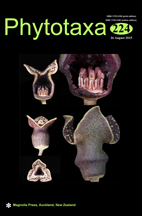Abstract
The genera Hydrolithon and Porolithon are the most discussed taxa of non-geniculate Corallinaceae, as well as the most poorly known. Anatomical observations based usually on thallus construction, number of epithallial cell layers, trichocyte arrangement, occurrence of vegetative filaments between the trichocytes, and presence/absence of cell fusions and secondary pit connections led to different interpretations mainly due to the lack of available reproductive material from type specimens. Recently molecular surveys on the phylogeny of the Corallinales supported the hypothesis of considering Hydrolithon and Porolithon as two distinct genera but, up to now, several taxonomic questions remain in part unanswered. For these reasons identification of species belonging to these genera is still very difficult and can often lead to misidentification of taxa. In this study we report the discovery of a species of the Hydrolithon group found along the coast of Vis Island, Croatia, Adriatic Sea. Samples were identified through morpho-anatomical examinations and the phylogenetic position of this species was investigated through molecular analyses based on the nuclear nSSU and the plastidial psbA markers. This finding represents the first report for the Mediterranean Sea of Hydrolithon rupestre, one of the few encrusting coralline algae reported to overgrow live corals. The species can represent a possible threat to populations of Adriatic scleractinian corals.

